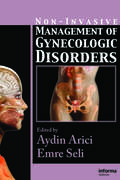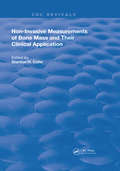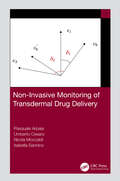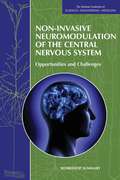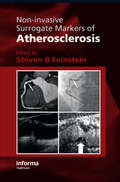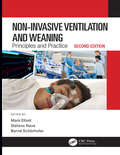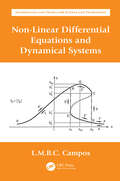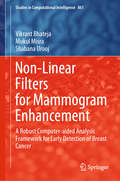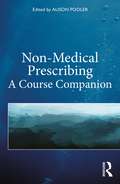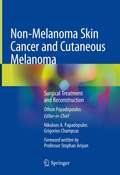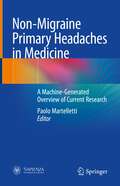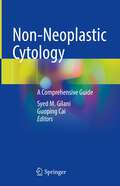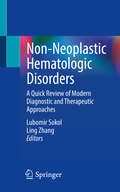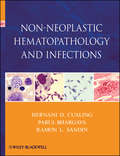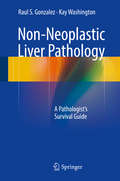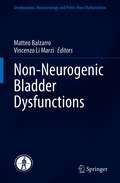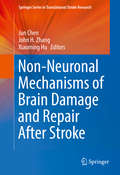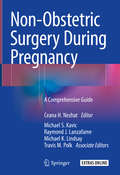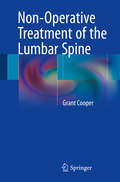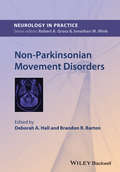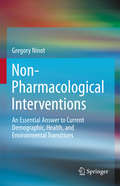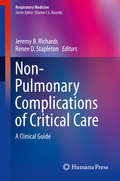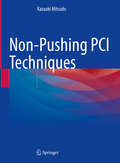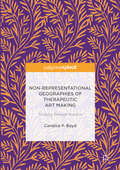- Table View
- List View
Non-Invasive Management of Gynecologic Disorders
by Emre Seli Aydin AriciNon-invasive options for the management of gynecologic conditions continue to grow in popularity, as they offer considerable benefits in reduced patient stress, hospitalization time, and cost. Non-invasive Management of Gynecologic Disorders provides an informative, concise, and highly practicable resource for the diagnosis and management of gyneco
Non-Invasive Measurements of Bone Mass & Their Clinical Application (Routledge Revivals)
by Stanton H. CohnFirst Published in 1981, this book offers a full, comprehensive guide to measuring bone mass. Carefully compiled and filled with a vast repertoire of notes, diagrams, and references this book serves as a useful reference for students of osteology, and other practitioners in their respective fields.
Non-Invasive Monitoring of Transdermal Drug Delivery
by Pasquale Arpaia Umberto Cesaro Nicola Moccaldi Isabella SanninoThe book presents an innovative technology based on injection of a very weak current to trace the quantity of a drug carried immediately after the administration. The book makes the reader familiar with the technology, from the conception through the design of the instrument, up to the preliminary clinical applications. In the first chapter, the method of transdermal drug delivery and the use of impedance spectroscopy in the dermatological field are presented. The second chapter describes a screening measurement campaign aimed at proving the feasibility of the assessment method and identifying the bandwidth of interest. The prototyping, validation and characterization of an instrument to measure the amount of drug delivered (DUSM: Drug Under Skin Meter) are presented in chapter three. In the fourth chapter three experimental campaigns, based on the electrical analysis of the biological tissue behavior due to the drug delivery, are reported: (i) laboratory emulation on eggplants, (ii) ex-vivo tests on pig ears, and finally (iii) in-vivo tests on human volunteers. In the fifth chapter a behavioral model, based on Finite Elements and Partial Differential Equation, of an impedance-based measurement system for assessing the drug released under the skin, during transdermal delivering, is proposed. The last chapter is dedicated to present a campaign in order to prove the suitability for insulin therapy applications. This book is intended for biomedical engineers, biomedical engineering students, operators working in the field of biomedical instrumentation, biotechnologists, and technicians of transdermal vehiculation.
Non-Invasive Neuromodulation of the Central Nervous System: Workshop Summary
by Lisa BainBased on advances in biotechnology and neuroscience, non-invasive neuromodulation devices are poised to gain clinical importance in the coming years and to be of increasing interest to patients, clinicians, health systems, payers, and industry. Evidence suggests that both therapeutic and non-therapeutic applications of non-invasive neuromodulation will continue to expand in coming years, particularly for indications where treatments are currently insufficient, such as drug-resistant depression. Given the growing interest in non-invasive neuromodulation technologies, the Institute of Medicine's Forum on Neuroscience and Nervous System Disorders convened a workshop, inviting a range of stakeholders - including developers of devices and new technologies, researchers, clinicians, ethicists, regulators, and payers - to explore the opportunities, challenges, and ethical questions surrounding the development, regulation, and reimbursement of these devices for the treatment of nervous system disorders as well as for non-therapeutic uses, including cognitive and functional enhancement. This report highlights the presentation and discussion of the workshop.
Non-Invasive Surrogate Markers of Atherosclerosis
by Steven B FeinsteinNon-Invasive Surrogate Markers of Atherosclerosis details the scientific and clinical support for using non-invasive imaging modalities to evaluate the presence of surrogate markers of atherosclerosis, in conjunction with traditional methods of diagnosing cardiovascular disease. This new book covers the topic completely
Non-Invasive Ventilation and Weaning: Principles and Practice, Second Edition
by Mark Elliott Stefano Nava Bernd SchönhoferNow in full-colour, this eagerly-anticipated second edition continues to be the most comprehensive resource available on non-invasive ventilation (NIV), both in the hospital and at home. Reflecting a global perspective with expert contributors from more than 15 countries, the book: <li>provides clinical examples of NIV in practice with insightful vignettes <li>covers home- and intensive care-based ventilation <li>details NIV use in acute and chronic respiratory failure, plus paediatric and other specialty applications. <P><P>Disease-specific sections provide best practice in the science, diagnostics and management of conditions such as COPD, cardiac failure, neuromuscular disease and obesity, while features such as ‘Common Clinical Questions & Answers’, abundant tables and illustrations, chapter summaries and new clinical vignettes showcase the realities of NIV in practice. This is essential reading for pulmonologists, critical care physicians and intensive care medicine specialists.
Non-Linear Differential Equations and Dynamical Systems (Mathematics and Physics for Science and Technology)
by Luis Manuel Braga da Costa CamposNon-Linear Differential Equations and Dynamical Systems is the second book within Ordinary Differential Equations with Applications to Trajectories and Vibrations, Six-volume Set. As a set, they are the fourth volume in the series Mathematics and Physics Applied to Science and Technology. This second book consists of two chapters (chapters 3 and 4 of the set). The first chapter considers non-linear differential equations of first order, including variable coefficients. A first-order differential equation is equivalent to a first-order differential in two variables. The differentials of order higher than the first and with more than two variables are also considered. The applications include the representation of vector fields by potentials. The second chapter in the book starts with linear oscillators with coefficients varying with time, including parametric resonance. It proceeds to non-linear oscillators including non-linear resonance, amplitude jumps, and hysteresis. The non-linear restoring and friction forces also apply to electromechanical dynamos. These are examples of dynamical systems with bifurcations that may lead to chaotic motions. Presents general first-order differential equations including non-linear like the Ricatti equation Discusses differentials of the first or higher order in two or more variables Includes discretization of differential equations as finite difference equations Describes parametric resonance of linear time dependent oscillators specified by the Mathieu functions and other methods Examines non-linear oscillations and damping of dynamical systems including bifurcations and chaotic motions
Non-Linear Filters for Mammogram Enhancement: A Robust Computer-aided Analysis Framework for Early Detection of Breast Cancer (Studies in Computational Intelligence #861)
by Vikrant Bhateja Shabana Urooj Mukul MisraThis book presents non-linear image enhancement approaches to mammograms as a robust computer-aided analysis solution for the early detection of breast cancer, and provides a compendium of non-linear mammogram enhancement approaches: from the fundamentals to research challenges, practical implementations, validation, and advances in applications.The book includes a comprehensive discussion on breast cancer, mammography, breast anomalies, and computer-aided analysis of mammograms. It also addresses fundamental concepts of mammogram enhancement and associated challenges, and features a detailed review of various state-of-the-art approaches to the enhancement of mammographic images and emerging research gaps. Given its scope, the book offers a valuable asset for radiologists and medical experts (oncologists), as mammogram visualization can enhance the precision of their diagnostic analyses; and for researchers and engineers, as the analysis of non-linear filters is one of the most challenging research domains in image processing.
Non-Medical Prescribing: A Course Companion
by Alison PoolerThis accessible textbook provides a comprehensive resource for healthcare students and professional students studying non-medical prescribing, taking into account the Royal Pharmaceutical Society (RPS) competency framework for non-medical prescribing. Non-Medical Prescribing: A Course Companion includes chapters on the context of non-medical prescribing; pharmacology; professional, legal and ethical issues; psychological influences; working in multidisciplinary teams; working with patients with complex conditions and co-morbidities; understanding antibiotics and resistances; prescription writing; and the role of non-medical prescribing leads. Each chapter acts as a self-contained study module, with key facts and areas highlighted, illustrative clinical cases to link learning to practice, and a self-test quiz. Designed for professionals from a range of non-medical disciplines including nursing, midwifery, pharmacy, physiotherapy and occupational therapy, this book can be used at both pre- and post-registration level.
Non-Melanoma Skin Cancer and Cutaneous Melanoma: Surgical Treatment and Reconstruction
by Othon Papadopoulos Nikolaos A. Papadopulos Grigorios ChampsasThis book describes and illustrates the reconstructive surgical techniques appropriate in patients with skin cancer and melanoma, according to anatomic region, with a view to enabling readers to perform these techniques optimally. An extensive introductory section discusses skin cancer and melanoma from the points of view of dermatology, oncology, pathology, radiotherapy, nuclear medicine, and plastic and reconstructive surgery. The surgical treatment and reconstruction of localized skin cancer and melanoma in each anatomic region are then explained step by step with the aid of a wealth of color photos. The final section similarly presents the techniques and procedures appropriate for the surgical treatment and reconstruction of lymph node metastases, covering the sentinel node, lymphadenectomy, and lymphedema. This book will be immensely valuable for plastic and general surgeons, and also of interest for dermatologists, pathologists, oncologists, and nuclear medicine physicians.
Non-Migraine Primary Headaches in Medicine: A Machine-Generated Overview of Current Research
by Paolo MartellettiThis book on tension-type headache is the second machine-generated scientific book in medicine published by Springer and reflects a new publication format which focuses on literature reviews: state-of-the-art computer algorithms were applied to select relevant sources from Springer Nature journal, rearrange them in a topical order, and provide short summaries of these articles. The result is the auto-summarization of current texts, organized by means of a similarity-based clustering routine in coherent chapters and sections. The human intervention of a world-renowned expert in this field grants the scientific soundness and appropriate organization of the contents identified. The AI-based approach seemed especially suitable to provide an innovative perspective as the topics are indeed both complex, interdisciplinary, and multidisciplinary, as is tension-type headache, the most diffuse among the chronic non communicable diseases. The result of this innovative process will of help especially for readers with limited time, interested in migraine and wishing to learn more about the subject quickly and if they are new to the topic. Springer seeks to support anyone who needs a fast and effective start in their content discovery journey, from the undergraduate student exploring interdisciplinary content, to Master- or PhD-thesis developing research questions, to the practitioner seeking support materials, this book can serve as an inspiration, to name a few examples.
Non-Neoplastic Cytology: A Comprehensive Guide
by Guoping Cai Syed M. GilaniCytology evaluates cellular details, and in contrast, histology relates to tissue assessment with rather preserved architecture. During daily cytology practice, we frequently encounter certain situations which are often challenging such as differentiating normal cytology components or non-neoplastic lesions from a neoplastic process, abnormality versus artifact, contaminants from lesional sampling, immunostain expression in unexpected cells, identifying/or characterizing infectious microorganisms and use of special stains. In-depth knowledge about normal tissue cytology, the pattern of immunohistochemical expression in various organs, and recognizing diagnostic pitfalls would help to overcome diagnostically challenging situations. This book presents a detailed and state-of-the-art approach to non-neoplastic cytology. High-yield content, mostly used in daily practice, is in tabular format. The book provides detailed information about cytomorphologic features of infectious microorganisms and the use of special stains, the use of immunohistochemistry along with expression in normal cell types, artifacts/contaminants or incidental findings, and cytomorphologic features of non-tumor related lesions in an organ-based structure. There is a further elaboration of differential diagnosis and mimickers of cytologic material from normal parenchymal tissue, infectious/inflammatory conditions, and benign cystic lesions. The last chapter describes a quick overview of important reference material in tables, which is useful for daily anatomic pathology sign-out. Non-Neoplastic Cytology: A Comprehensive Guide provides practical information about non-neoplastic cytology in one concise format using tables and images. It aims to be a practical resource for cytotechnologists, pathologists, pathology residents, and fellows.
Non-Neoplastic Hematologic Disorders: A Quick Review of Modern Diagnostic and Therapeutic Approaches
by Ling Zhang Lubomir SokolIn the current digital era with the exponential growth of medical knowledge, voluminous textbooks have gradually been replaced by the pocketbooks with tables, figures, images, and e-links to digital book versions with supplemental materials available online. The advent of novel next-generation sequencing (NGS) and multi-omics single cell methods have uncovered causative molecular mechanisms in most of the known non-neoplastic hematologic disorders. There is an urgent need for a concise and up-to-date handbook focused on non-malignant hematology. The book describes characteristic clinical features and state-of-the-art diagnostic approaches of non-neoplastic hematologic disorders. It introduces modern molecular biomarkers with enormous diagnostic and prognostic value and novel targeted gene therapy. Differential diagnosis also includes relevant hematologic malignancies that could represent diagnostic pitfalls. Chapters include take home points for each disorder in concise and easy memorable manner. The book also provides diagnostic algorithms, novel prognostic and predictive factors, up-to-date treatment options, clinically relevant molecular signatures, and ongoing promising clinical trials if available. There are more than 100 questions and answers with comments on laboratory values, updated cytogenetic and mutational profiles. Non-Neoplastic Hematologic Disorders: A Quick Review of Modern Diagnostic and Therapeutic Approaches provides concise clinical and laboratory information about most common non-neoplastic hematologic disorder for practicing hematologists, oncologists, hematopathologists, molecular pathologists, internal medicine specialists, pediatricians, research nurses, nurse practitioners, and trainees at all levels.
Non-Neoplastic Hematopathology and Infections
by Hernani Cualing Parul Bhargava Ramon L. SandinMost books on hematopathology are neoplastic in scope and offer little non-neoplastic content. In Non-Neoplastic Hematopathology and Infections, the authors fully describe the hematologic manifestations in tissue and blood of infectious agents, including many rare and exotic diseases found in both Western and Eastern hemispheres, in order to assist pathologists and medical laboratory professionals all over the world in better diagnosing and treating such infections. Thoroughly illustrated with photographs, tables and text, this book features a wide range of non-neoplastic hematologic disorders, as well as reactive patterns of non-infectious and infectious agents. Comprehensive and state-of-the-art diagnostic materials are described, as are the epidemiology, pathobiology, clinical and pathologic manifestations in blood and lymphatic organs—as well as the approaches to treatment. In addition, Non-Neoplastic Hematopathology and Infections: Contains detailed information on the pathology and patterns of blood, lymph node, and a number of bone marrow and splenic infections and infectious agent manifestations Thoroughly updates the classic pathology of reactive lymphadenopathies and extends this pattern-based approach to tropical and emergent infections Promotes the multidisciplinary integration of hematopathologists and microbiologists in the analysis and diagnostic work-up of tissue and blood Complements current major treatises on such tropical diseases as Manson's, Ashworth's, and Doerr's and updates the classic tomes of William St. Clair Symmers and current texts on neoplastic hematopathology Non-Neoplastic Hematopathology and Infections is an important book for any medical professional interested in non-neoplastic hematology, infections and tissue hematopathology, infectious diseases and tropical medicine, and tropical hematopathology.
Non-Neoplastic Liver Pathology
by Raul S. Gonzalez Kay WashingtonThis book provides a quick, pattern-based reference for interpreting histologic changes in non-neoplastic liver. It is designed to guide the reader based on morphologic pattern and basic clinical information. Each chapter covers a broad but identifiable pattern of pathologic liver findings (e. g. , "portal inflammation" or "steatosis") and discusses the major disease entities that manifest as such a pattern. As liver biopsies can be complex and daunting, such an approach should improve the reader's ability to identify a likely diagnosis or differential and to distinguish among the possible disease entities. Sample reports at the end of each chapter offer guidance on how to sign out cases. Non-Neoplastic Liver Pathology: A Pathologist's Survival Guide will be of value to practicing pathologists without specialized training in hepatic pathology, pathology residents and fellows trying to learn the basics of non-neoplastic liver pathology, and hepatologists interested in reviewing liver biopsies with pathologists
Non-Neurogenic Bladder Dysfunctions (Urodynamics, Neurourology and Pelvic Floor Dysfunctions)
by Vincenzo Li Marzi Matteo BalzarroThis book is exclusively devoted to the often-challenging diagnosis, management and treatment of patients with non-neurogenic bladder dysfunction. A unique team of experts in the field report on the state of the art and the latest trends concerning overactive and underactive bladder dysfunctions, while also discussing detrusor overactivity impaired contractility. Given its scope, the book will benefit all urologists, and offers a valuable tool for professionals and physicians who care and deal with patients with non-neurogenic bladder dysfunctions.
Non-Neuronal Mechanisms of Brain Damage and Repair After Stroke
by John H. Zhang Jun Chen Xiaoming HuThis book provides a comprehensive overview of the latest research in the role of non-neuronal cells - astrocytes, oligodendrocytes, endothelial cells, pericytes, microglia, and other immune cells in ischemic brain injury and long-term recovery. In these cases, neurodegeneration and brain repair are controlled in a sophisticated system, incorporating interactions between different cell types and cellular systems. Also explored are the therapeutic strategies that target non-neuronal responses after stroke and their translational potentials.
Non-Obstetric Surgery During Pregnancy
by Ceana H. Nezhat Michael S. Kavic Raymond J. Lanzafame Michael K. Lindsay Travis M. PolkAs minimally invasive surgical techniques evolve, the outlook for patients continues to brighten. This is also true for pregnant women experiencing conditions requiring surgical intervention during gestation. A physician’s ability to identify potential risk factors in pregnant patients that present pre-op directly corresponds with their success in monitoring patients in post-op for adverse obstetric outcomes from non-obstetric surgeries. The utilization of laparoscopic techniques during surgery for pregnant patients has decreased the risk of fetal complications and increased the positive outlook for the duration of the pregnancy. This text is designed to present a minimally invasive approach to surgery that is non-obstetrics related and to educate readers on the potential risk factors and negative outcomes on pregnant patients following non-obstetric surgery. The various sections of this book will address issues faced by surgeons who undertake the task of operating on the pregnant patient. When performing non-obstetric surgery on a pregnant patient the ability to identify possible risk factors for adverse obstetric outcomes is important. Risk factors can be maternal-, surgical-, obstetrical-, or disease-associated. Common adverse obstetric outcomes following non-obstetric surgery include preterm delivery, preterm labor without preterm delivery, and miscarriage. Fetal well-being is an additional risk-benefit factor to be considered when weighing options before conducting non-obstetric surgeries on pregnant patients. This book will provide physicians with the knowledge and tools to identify common risk factors and successfully apply evidence-based risk reduction. To date, no comprehensive resource is available for non-obstetric surgery during pregnancy. Types of pregnancies, potential complications, proper use of anesthesia, types of risk factors (maternal-, surgical-, obstetrical-, and disease-associated), etc. will be thoroughly explained and depicted within these pages. All chapters will be written by subject matter experts in their fields. All information communicated will be comprised of the most currently available knowledge
Non-Operative Treatment of the Lumbar Spine
by Grant CooperBridging the gap between the medical literature and the practice of lumbar spine medicine, this user-friendly, accessible text describes the causes of lower back pain and associated "sciatic" pathologies and how these problems can be successfully treated without surgery. Beginning with a review of the anatomy of the lumbar spine and the most common causes of lower back pain, diagnostic and management strategies for a variety of conditions are discussed, including discogenic pain, facet joint pain, sacroiliac joint pain, spondylolisthesis, lumbar radiculopathy, piriformis syndrome, spinal stenosis, and compression fractures. Chapters on epidural steroid injections, exercises for lower back pain and alternative treatments follow, as well as when it is appropriate to recommend surgery. The second section of the book is devoted to numerous clinical scenarios in which evidence based medicine is applied to actual clinical cases. Non-Operative Treatment of the Lumbar Spine will be a valuable reference for orthopedists, rheumatologists, physiatrists, pain management specialists, neurologists, and anyone treating patients with lower back pain.
Non-Parkinsonian Movement Disorders
by Brandon R. Barton Deborah A. HallA clinical ‘in the office’ or ‘at the bedside’ guide to effective patient care for neurologists in practice and in training Each presentation includes practical descriptions of phenomenology, and key clinical information from the history and neurological examination that guide the physician to the correct diagnosis, and treatment options Throughout the book Science Revisited highlights remind clinicians of the scientific anchors related to each disorder, and Evidence at a Glance boxes summarise clinical trial evidence-based review information Numerous video clips in every chapter demonstrate different movement disorders to aid diagnosis Unique learning tools, Tips and Tricks and Caution Warning boxes, give useful hints on improving outcomes and preventing errors
Non-Pharmacological Interventions: An Essential Answer to Current Demographic, Health, and Environmental Transitions
by Gregory NinotNon-pharmacological interventions (NPIs) have become essential solutions for better living, preventing disease, and self-care, in addition to biomedical treatments, and for increasing longevity without loss of quality of life. Over the past 20 years, these practices have gone from general diet and hygiene advice to targeted and personalized solutions for prevention, care optimization, and curative treatments. Selected empirically for centuries or recently with the help of technological innovations and epigenetic, interventional, and medico-economic studies, their development is growing and diversifying around the world. Today an NPI ecosystem is made up of a myriad of public and private actors. As interest in NPIs grows, so do questions about safety, effectiveness, standardization, ethical practice, and surveillance. In this book, the author answers these questions with a scientific approach, because evidence-based science, evidence-based practice, clinical research, and data monitoring have revolutionized this field. Topics explored among the chapters include: · Defining Non-Pharmacological Interventions · The Benefits and Dangers of Non-Pharmacological Interventions · Motives and Facilitators of Non-Pharmacological Intervention Use · The Market for Non-Pharmacological Interventions · Evaluation of Non-Pharmacological Interventions · The Future of Non-Pharmacological Interventions Non-Pharmacological Interventions: An Essential Answer to Current Demographic, Health, and Environmental Transitions is a must-have resource for clinicians and other health professionals, researchers, students, health insurers, policy-makers, caregivers, and entrepreneurs in the health and wellness space, as well as any users who wish to inform themselves about NPIs.
Non-Pulmonary Complications of Critical Care
by Jeremy B. Richards Renee D. StapletonClinical research in critical care has exploded in the past several years and we now have a much better understanding of how to care for intensive care unit (ICU) patients in areas such as management of sepsis, fluid resuscitation, mechanical ventilation, antibiotic administration and sedation and analgesia. However, despite improved clinical care, many critically ill patients continue to experience complications of critical illness - some complications are iatrogenic and preventable, while others are simply a component of the natural history of critical illness. These complications lead to increased mortality, morbidity, cost and long-term chronic conditions. Non-Pulmonary Complications of Critical Care: A Clinical Guide is a valuable resource for trainees and clinicians who aim to better understand and improve the quality of critical care medicine. Armed with information about potential non-pulmonary complications of ICU care and strategies to minimize or prevent those complications, the critical care clinician will be able to help ICU patients potentially avoid much of the morbidity associated with critical illness. This book is organized by organ system such that it can be easily used as a bedside reference. Complications caused by pharmaceuticals are dispersed throughout every chapter and the concluding chapters provide a special emphasis on meticulous supportive care of the critically ill patient to allow the best chance for recovery.
Non-Pushing PCI Techniques
by Kazuaki MitsudoThis book provides an in-depth review of non-pushing percutaneous coronary intervention (PCI). With abundant, clear figures, the chapters logically describe retrograde wiring techniques, including the stenting of bifurcation lesions, right coronary artery ostial lesions, and left main trunk (LMT) lesions, and then go on to illustrate Mitsudo’s non-pushing PCI techniques. Short columns between chapters offer tips and tricks to help readers gain a better understanding.Given its scope, this book is not only a valuable resource for by coronary interventionalists dealing with PCI for complex lesions including chronic total occlusion (CTO), but also serves as a practical and informative for cardiologists.
Non-Representational Geographies of Therapeutic Art Making
by Candice P. BoydUtilising non-representational theories and practice-led research methods, this book serves to reclaim therapeutics as ecological, spatial and material. It examines the sites and performances of a wide range of therapeutic art practices, including painting and drawing, dance movement therapy, fibre art, subterranean graffiti practice, and poetic permaculture. In doing so it provides an important assessment of the role and status of therapy in contemporary life. A highly interdisciplinary text, Boyd’s research is informed by a thorough reading of post-structural theory including contemporary feminism, Guattari’s ethico-aesthetic paradigm, Whitehead’s process-oriented ontology, and Deleuze’s writing on sense and the event. This innovative study will prove essential for scholars and practitioners of cultural geography, socially-engaged art, therapeutic studies, and occupational therapy.
Non-Sighted and Sighted Adults' Volumetric Perceptions of Functional Objects
by T. M. Nelson C. J. Ladan J. EppsA report on the study of the manner in which sighted, sighted-but-blindfolded, late-blind (subsequent to 7 years of age), and congenitally blind (blind since birth) persons employ physical parameters in determining weight and volume of functional objects.
